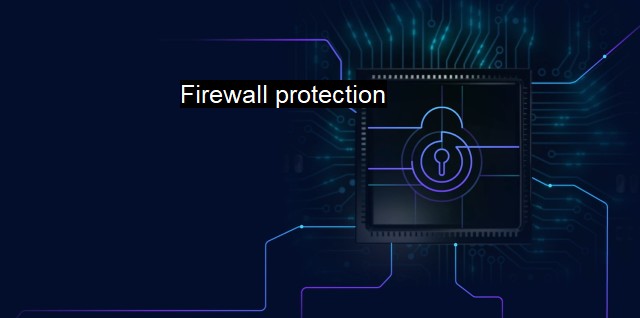What is Firewall protection?
Strengthening Cybersecurity: The Crucial Role of Firewall Protection and Antivirus in Safeguarding Confidentiality, Integrity, and Availability
In the digital age, the safety of personal and corporate information is ever more a front-and-center issue. The prime defender in the cybersecurity cosmos against unauthorized infiltration into a computer system is the firewall; an unsung and often underrated hero. Firewall protection contributes substantially to our collective peace of mind within the feverishly evolving landscape of cybersecurity. This article discusses what firewall protection is, elucidating the subject within the wider context of cybersecurity and antivirus.Firstly, a concise definition might best serve our inquiry: a firewall, simply put, is a network security system that monitors and regulates incoming and outgoing network traffic based on predetermined security rules. It establishes a barrier between secured and controlled internal networks that an individual or organization can trust and external networks such as the internet, which might not be trustworthy. This metaphorical “firewall” functions akin to a physical firewall in the sense that it obstructs the spread of digital “fires,” or threats to security.
Firewalls can be either hardware or software or even a combination of both. Hardware firewalls refer to physical devices connected to the network, whereas software firewalls pertain to programs that you can install on your system. Hardware firewalls are generally regarded as more robust in their protection and are ideal for entities with hefty security demands, like larger corporations. Conversely, software firewalls, being more user-friendly and less costly, are excellent for individual users or small businesses.
The functionalities of a firewall delve deeper into the realm of cybersecurity than just forestalling unwarranted access. They can conceal the makeup of a computer network, cloak a user’s IP address making the system a hard-to-hit target for potential attackers. They can also manage and control network-related configurations and block specific sites that gain regard as unsafe or that the user prefers not to access. Researchers regularly update firewall systems to combat the latest cyber threats, ensuring top-notch system security.
In the context of antivirus, firewall protection plays an imperative role. While antivirus software detects and eliminates malicious software, once they have breached the computer's defenses, firewall protection thwarts these threats at the entrance gate itself. The firewall inspects each "packet" of data sent to your device to determine if it's safe. Packets deemed unsafe are rejected. Hence, firewall protection is effectively first-line cyber defense. It’s worth noting that while standalone antivirus and firewall protection each render substantial protection, operating them together in tandem provides the most exhaustive preventive setup.
Just as firewalls vary in form (hardware or software), they also differ in protection type. At a broad level, there are two types: network firewalls and host-based firewalls. Network firewalls, like the name suggests, safeguard an entire network by blocking unauthorized incoming or outgoing access. Host-based firewalls, on the other hand, are installed on individual devices, giving user-controlled protection.
Critically, safeguarding a computer system isn’t simply the installation and momentary configuration of antivirus or firewall protection; it’s ongoing. As firewall stakeholders continue the soft arm-wrestle of infiltration and counteraction, system custodians should maintain timely firewall updates and checks. A failure to adapt and evolve in the face of competitive hackers can render the most impregnable of firewall systems impotent.
Within a world increasingly relying on digital, Firewall protection stands as a counter-monolith to the looming threat of cyber attacks and data breach. Working quietly but resolutely, it ensures our online workspace remains ours and reinforces the fortifications antivirus programs help construct, rendering an indispensable service in the chain-link of cybersecurity. We too play our part, maintaining relevance of protection measures, understanding threats, and thus protecting ourselves and our data. As we enjoy the digital age's benefits, our responsibility towards vigilance increases simultaneously, aided quantifiably by robust and effective firewall protection.

Firewall protection FAQs
What is firewall protection and why is it important in cybersecurity?
Firewall protection is a security measure that monitors and controls incoming and outgoing network traffic based on predetermined security rules. It's crucial for cybersecurity as it prevents unauthorized access to your network and helps to keep sensitive data secure.What are the different types of firewall protection?
There are several types of firewall protection, including packet filtering, stateful inspection, proxy firewall, and next-generation firewall. Each type has its own strengths and weaknesses, and the most suitable option depends on the specific needs of your organization.Can antivirus software replace a firewall for protection?
No, antivirus software and firewalls play different roles in cybersecurity. Antivirus software detects and removes malicious software from your system, while firewalls monitor traffic to and from your network and block unauthorized access. It's recommended to use both antivirus and firewall protection for comprehensive cybersecurity.What are some best practices for maintaining firewall protection?
To maintain effective firewall protection, it's essential to keep it up-to-date with the latest security patches and firmware updates. Regularly monitoring and analyzing firewall logs can also help identify potential threats and improve security policies. Additionally, segmenting your network and configuring appropriate access controls can further enhance firewall protection.| | A | | | B | | | C | | | D | | | E | | | F | | | G | | | H | | | I | | | J | | | K | | | L | | | M | |
| | N | | | O | | | P | | | Q | | | R | | | S | | | T | | | U | | | V | | | W | | | X | | | Y | | | Z | |
| | 1 | | | 2 | | | 3 | | | 4 | | | 7 | | | 8 | | |||||||